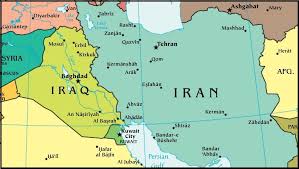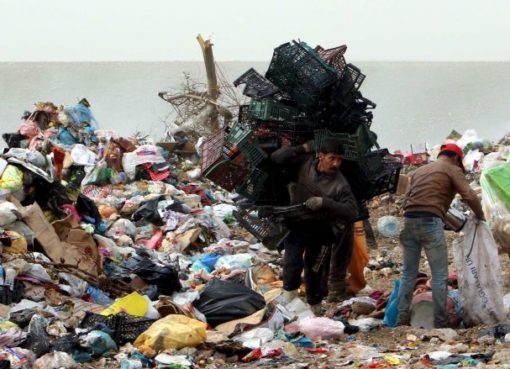How Iraq is Driving Itself to Hunger
Every day, Iraq inches closer to hunger. The United Nations estimates that approximately 4.4 million people across Iraq require food assistance. About 30 percent of Iraqis live below the national poverty line, and this number is much higher in the poorest districts.
These communities are already struggling with limited resources and basic foodstuffs, a situation made worse by the growing number of internally displaced persons (IDPs). The country faces a stark and multifaceted food security challenge. In the short term, protracted conflict is generating localized food shortages. In the longer term, inflexible policies and government illiquidity are leading to decreased domestic food production and higher import dependency.
In June 2014, with the Islamic State’s (IS) incursion into Salahuddin, Nineveh, Kirkuk, and Anbar—the breadbasket governorates comprising Iraq’s cereal belt—the country lost the majority of its annual wheat and barley harvests from these areas, which combined contributed over one-third of Iraq’s cereal production. About 1 million tons of wheat was lost in total. Moreover, of the harvest stored in government silos, much was expropriated by IS and transferred to Syria, and what the farmers kept was confiscated, bought at depressed prices, or left to rot.
The increasing number of IDPs, now estimated at around 3 million, together with about 250,000 refugees from Syria, has put an extra strain on the food supply and remaining strategic reserves in Iraq. The government has been unable to deliver food assistance to the displaced through its Public Distribution System (PDS) because of inflexible supply chains—preventing, for example, displaced Iraqis from Salahuddin’s Tikrit from collecting their monthly basket in Erbil or Baghdad. Government reserves of the main commodities in the PDS’s food basket are already understocked, and the government has not physically moved foodstuffs to IDPs’ destinations, where demand has spiked. Cash shortages have also prevented the government from replacing the physical commodities with cash transfers to those in need.
Because the conflict has disrupted the harvest and planting cycles, Iraq’s food insecurity is on track to worsen. Most arable land in central Iraq is either under Islamic State control or is the site of ongoing military operations. Farmers already living in IS-controlled areas do not have access to government-subsidized seeds and fertilizers, and those in disputed areas are blocked from accessing their fields. For instance, in the mixed Turkmen and Sunni Arab town of Amerli in Salahuddin, after the IS siege of the community ended in October, pro-government militias subsequently prevented surrounding Arab villages from returning to their lands.
For those areas where farmers were able to plant crops, such as in northern Nineveh, farmers are not able to harvest their crops due to such issues as a lack of machinery or fuel, unexploded mines in their fields, and inter-ethnic retribution. In October, the Kurdish peshmerga forces pushed the Islamic State out of the northern Ninewa region, which has a production capacity of nearly 600,000 tons of wheat and barley, enough to cover the assistance needs of IDPs in the Kurdistan regions. But in some areas, including Zumar, farmers cannot harvest their fields because most of the area’s machinery was stolen by the Islamic State when they seized the city. Meanwhile, in Sinjar, Yazidi communities burned the wheat fields of Arab farmers in the area as retribution for collaborating with IS. With northern Nineveh now under Kurdish control, entire Arab villages have been destroyed in reprisal and to deter IS re-infiltration.
Policy is another cause of Iraq’s food insecurity. Iraq’s 2015 budget has not allocated money for the purchase of grains from IS-controlled areas, partly for fear of transferring cash into the group’s hands and partly due to political calculations that are leaving Sunni areas without government support. As a result, the 2015 harvest—which has already started in Salahuddin, Nineveh, and Anbar—will have no one to purchase it. For the second year running, this means a resulting deficit of one million tons of grains (about one-third of Iraq’s typical annual domestic production, or enough to feed about 4-5 million people). For farmers, not being paid for their grain production means a loss of income and, in turn, increased debt. At the community level, this will exacerbate social disunity as more communities fall into poverty, which makes them more susceptible to radicalization.
For the government, the continued loss of grain production means an increased need for imports to satisfy demand and to close the food supply gap. But amid low global oil prices, and with a growing part of the oil income being channeled toward war efforts and debt payments, Iraq will face difficulties in procuring the necessary amount of food for its people. To address budget deficits, Iraq has increased oil production and the IMF agreed to a loan of $833 million, with theWorld Bank voting in July on another possible $800 million loan. But even with Iraq using its Special Drawing Rights (SDRs), foreign exchange reserve assets operated by the IMF, the central government is still suffering from illiquidity. This is translating into unfavorable payment terms for international commodity trading, even for lower-quality goods.
Meanwhile, aggravating the government’s fiscal position, smugglers from Turkey and Iran are selling these countries’ wheat production to the Iraqi government as Iraqi grain—in order to benefit from Iraq’s subsidized price of about $600 per ton, which is around double the global market rate. Not only is this subsidy—intended to support agriculture and Iraqi farmers—misdirected away from its intended benefactors, but the cash it uses gets funneled outside to neighboring countries, rather than staying in circulation within the Iraqi economy.
Local and international humanitarian and development organizations can fill but a small gap. On the food demand side, they can give the recently displaced food aid through family parcels for a limited time, but they cannot replace the PDS and other forms of government support. And while the international aid agencies aim to procure food locally as much as possible, such as wheat for the flour in food baskets, they can only afford to purchase small quantities. On the supply side, the international organizations can assist farmers with seed and fertilizer distribution, but only enough for them to maintain subsistence. This agricultural aid cannot be sustainable, especially as international donor fatigue exacerbates aid agencies’ budget constraints.
The protracted crisis in Iraq, coupled with the inflexible policies of the government and its fiscal challenges, are pushing the country and its population toward food insecurity. Proactive policy-making and aid are needed to thwart an impending vicious cycle that starts with hunger and feeds back into the protracted conflict.
By Hadi Fathallah is an economist and policy adviser focusing on food security, energy, trade and political risk. He is a fellow of the Cornell Institute for Public Affairs and a Global Shaper with the World Economic Forum. The views expressed in this article do not necessarily represent those of the institutions he works for or is affiliated with.








Comment here